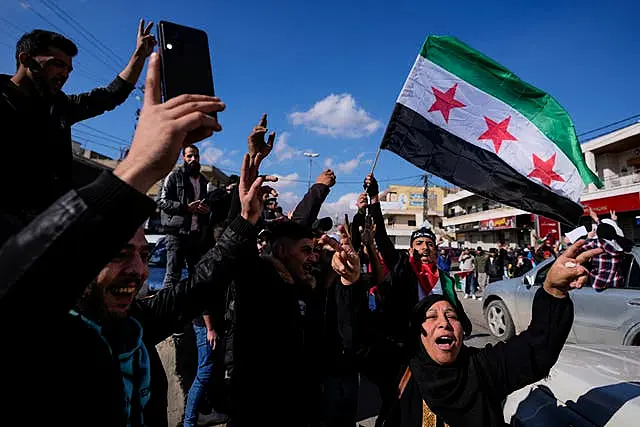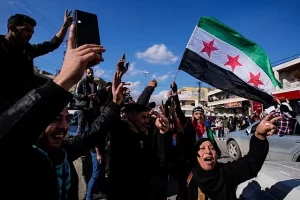
Syrians celebrate in wake of Syrian government collapse

The Syrian government fell early Sunday in a stunning end to the 50-year rule of the Assad family after a sudden rebel offensive sprinted across government-held territory and entered the capital in 10 days.
Syrian state television aired a video statement by a group of men saying that President Bashar Assad has been overthrown and all detainees in jails have been set free.

The man who read the statement said the Operations Room to Conquer Damascus, an opposition group, called on all opposition fighters and citizens to preserve state institutions of “the free Syrian state.”
The statement emerged hours after the head of a Syrian opposition war monitor said Assad had left the country for an undisclosed location, fleeing ahead of insurgents who said they had entered Damascus following the remarkably swift advance across the country.
Syrian Prime Minister Mohammed Ghazi Jalali said the government was ready to “extend its hand” to the opposition and turn its functions over to a transitional government.
“I am in my house and I have not left, and this is because of my belonging to this country,” Jalili said in a video statement. He said he would go to his office to continue work in the morning and called on Syrian citizens not to deface public property.
He did not address reports that Assad had fled.
Rami Abdurrahman of the Syrian Observatory for Human Rights told The Associated Press that Assad took a flight Sunday from Damascus.
State television in Iran, Assad’s main backer in the years of war in Syria, reported that Assad had left the capital. It cited Qatar’s Al Jazeera news network for the information and did not elaborate.
There was no immediate statement from the Syrian government.
As daylight broke over Damascus, crowds gathered to pray in the city’s mosques and to celebrate in the squares, chanting “God is great.” People also chanted anti-Assad slogans and honked car horns. In some areas, celebratory gunshots rang out.
Soldiers and police officers left their posts and fled, and looters broke into the headquarters of the Ministry of Defense.
“My feelings are indescribable,” said Omar Daher, a 29-year-old lawyer. “After the fear that he [Assad] and his father made us live in for many years, and the panic and state of terror that I was living in, I can’t believe it.”
Daher said his father was killed by security forces and his brother was in detention, his fate unknown. Assad “is a criminal, a tyrant and a dog,” he said.”
“Damn his soul and the soul of the entire Assad family,” said Ghazal al-Sharif, another reveler in central Damascus. “It is the prayer of every oppressed person and God answered it today. We thought we would never see it, but thank God, we saw it.”
The police headquarters in the capital appeared to be abandoned, its door left ajar with no officers outside. An Associated Press journalist shot footage of an abandoned army checkpoint where uniforms were discarded on the ground under a poster of Assad’s face. Footage broadcast on opposition-linked media showed a tank in one of the capital’s central squares.
It was the first time opposition forces had reached Damascus since 2018, when Syrian troops recaptured areas on the outskirts of the capital following a yearslong siege.
The pro-government Sham FM radio reported that the Damascus airport had been evacuated and all flights halted.
The insurgents also announced they had entered the notorious Saydnaya military prison north of the capital and “liberated” their prisoners there.
The night before, opposition forces took the central city of Homs, Syria’s third largest, as government forces abandoned it. The city stands at an important intersection between Damascus, the capital, and Syria’s coastal provinces of Latakia and Tartus — the Syrian leader’s base of support and home to a Russian strategic naval base.
The rebels had already seized the cities of Aleppo and Hama, as well as large parts of the south, in a lightning offensive that began November 27. Analysts said rebel control of Homs would be a game-changer.
The rebels’ moves into Damascus came after the Syrian army withdrew from much of southern part of the country, leaving more areas, including several provincial capitals, under the control of opposition fighters.
The advances in the past week were by far the largest in recent years by opposition factions, led by a group that has its origins in al-Qaida and is considered a terrorist organization by the U.S. and the United Nations. In their push to overthrow Assad’s government, the insurgents, led by the Hayat Tahrir al-Sham group, or HTS, have met little resistance from the Syrian army.
The U.N.’s special envoy for Syria, Geir Pedersen, called Saturday for urgent talks in Geneva to ensure an “orderly political transition.” Speaking to reporters at the annual Doha Forum in Qatar, he said the situation in Syria was changing by the minute. Russian Foreign Minister Sergey Lavrov, whose country is Assad’s chief international backer, said he feels “sorry for the Syrian people.”
In Damascus, people rushed to stock up on supplies. Thousands went to Syria’s border with Lebanon, trying to leave the country. Lebanese border officials closed the main Masnaa border crossing late Saturday, leaving many stuck waiting.
Many shops in the capital were shuttered, a resident told The Associated Press, and those still open ran out of staples such as sugar. Some were selling items at three times the normal price.
Meanwhile, hours after Syrian rebel forces announced the overthrow of Syrian President Bashar Assad’s regime, Turkish-backed armed groups launched an attack Sunday on a town in northern Syria under the control of U.S.-backed, Kurdish-led forces.
The Syrian National Army, or SNA, a coalition of Turkish-backed militias, announced advances in several parts of Manbij, a town in northern Syria, as intense clashes erupted with fighters from the Kurdish-led Syrian Democratic Forces (SDF), according to the Turkey’s state-run Anadolu.
But the Manbij Military Council, which is affiliated with the SDF, denied that “large parts of the city” have been controlled by Turkish-backed groups, saying in a statement Sunday that its fighters were continuing their military mission in Manbij.
The SDF said that several administrative buildings in Manbij were targeted in Turkish military strikes. The Turkish military has not commented on the developments in the city.
Manbij, located in Aleppo province, has been under the control of U.S.-backed SDF fighters since it was liberated from Islamic State militants in 2016. But Turkey, which views the SDF as a terrorist organization, has been supporting rebel groups in efforts to expel the Kurdish-led forces from the area.
A reporter with VOA’s Kurdish Service in northern Syria said that after hours of fierce fighting between the two sides, some Turkish-backed groups have retreated from Manbij while others remain positioned outside the city. He added that SNA’s Sunday attack was aided by some sleeper cells inside the city.
The 11-day rapid rebel offensive across the country, led by Hayat Tahrir al-Sham, a U.S.-designated terrorist organization, resulted in the capture of the capital Damascus and other strategic cities in northwest and central Syria. Simultaneously, an operation led by SNA factions aimed at dislodging Kurdish forces from parts of Aleppo province.
Following the collapse of the Syrian regime in Damascus, SDF General Commander Mazloum Abdi stated that the country was experiencing a historic moment.
“This change is an opportunity to build a new Syria based on democracy and justice that guarantee the rights of all Syrians,” he said on social media platform X, formerly Twitter.
VOA



